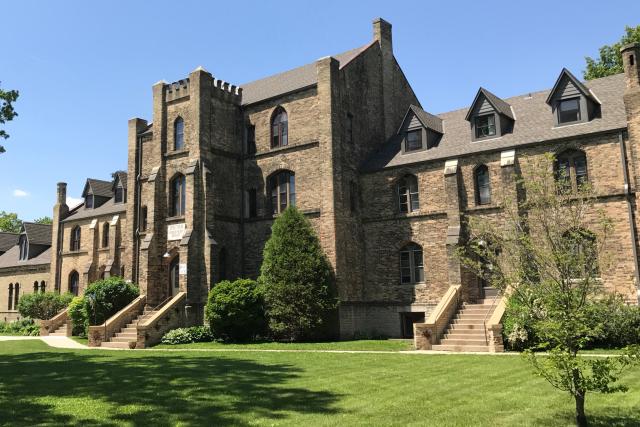Racine County has fascinating architecture, local history, home-grown art, and much more! If you're an architecture enthusiast, here's a curated itinerary for you to enjoy exploring our county! Many places listed are on the National Register of Historic Places.
The DeKoven Center
600 Caron Butler Dr., Racine
The DeKoven Center began as Racine College, founded and chartered in 1852. Its first building was constructed that same year, and is now part of the East Building paralleling Lake Michigan. In 1859, Dr. James DeKoven came to Racine College from St. John's School in Delafield to become Warden of the College. It was Dr. DeKoven who gave the campus its focus, modeling the quadrangle on English colleges, with faculty and students living on the campus and eating together in a common Refectory, today known as the Great Hall.
The old college motto,"Vigeat Radix" (May the Root Thrive), is as appropriate today as it was in the early 1850s. The work of the DeKoven Foundation thrives today, with Taylor Hall, the gym, and the pool as its retreat center. St. John's Chapel stands in the middle of one of the oldest intact collegiate quadrangles in America and hosts numerous weddings and services each year. Wedding receptions are held in both the Assembly Hall and the Great Hall. St. Mary's Chapel has striking carved wood reredos and an altar, unusual clear glass Gothic windows, and a baby grand piano.

(photo: Wisconsin Historical Society)
Racine City Hall
730 Washington Ave., Racine
Built in 1930, Racine City Hall was designed by J. Mandor Matson in the Neoclassical architectural style. The first mayor to occupy offices in this building was William J. Swoboda, a socialist elected in 1931, 1933, and 1935. The building is clad in limestone. The first floor windows and entrance have Roman arch surrounds, and the second and third floor windows are six-pane rectangular casements separated by pilasters on the façade of the entry bay. A simulated balcony exists over the main entrance. A decorative cornice runs the perimeter of the building just below the roofline. The words "Racine City Hall" are in relief just above the third floor windows on the front façade.
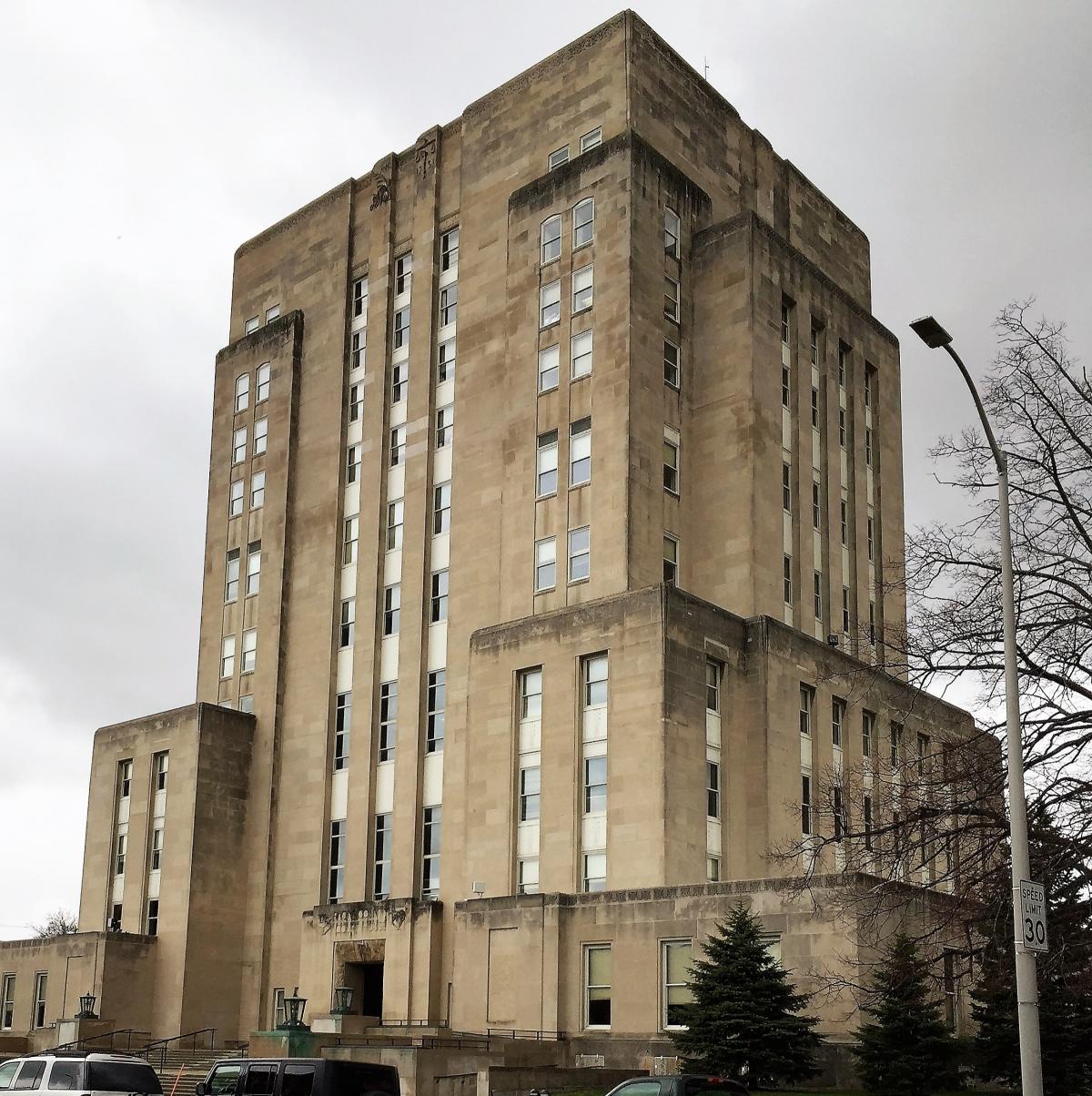
Racine County Courthouse
730 Wisconsin Ave., Racine
The Racine County Courthouse was designed in 1930 by Holabird & Root Architects of Chicago, Illinois (their famous architecture includes Soldier Field, Wrigley Field Hand-Turned Scoreboard, and Center Field Bleachers). Constructed at the cost of $1.5M, the art deco style building was completed and occupied in July 1931. In 1984, the building was remodeled and repaired at the cost of $7M. Reaching 155 feet high, this 11-story building has a sub-basement and basement. The exterior is faced with Bedford limestone from Indiana. Materials used in and throughout the building are stone and marble. There are six courtrooms finished in American Walnut, Austrian and English Oak.

Firehouse 3 Museum
700 6th St., Racine
Engine Company No. 3 was formed in 1849, one year after Racine was incorporated as a city. The volunteer company was made up almost exclusively of Welsh immigrants. The company's original home was located on 7th Street between Main Street and Wisconsin Avenue, and was used used as a firehouse until 1868. A new building on 6th Street was constructed in 1881 and designed in a Victorian Italianate style by David R. Jones, an architect from Madison, Wisconsin. The two-story cream brick building features a tower, stone accents, stilted segmental arched windows and front door, and a denticulated cornice. Two years after Engine Company No. 3 moved into their new home, the Racine Fire Department changed from volunteer service to a professional company. Several alterations were made to the building over the years, but it was partially restored in 1987 and today is used as a firefighters museum.

SC Johnson Administration Building and Research Tower
1525 Howe St., Racine
The largest commercial project designed by Frank Lloyd Wright, the SC Johnson Administration Building, was completed in 1939. The Great Workroom of the building contains almost one-half acre of floor space. From its 43 miles of Pyrex glass tubing to the soaring dendriform columns that are nine inches in diameter at the base and 18.5 feet at the top in the Great Workroom, it is truly a unique work of art that reflects the innovation and adventure that are still the spirit of SC Johnson today. The ceiling is supported by large golf-tee shaped columns that have been termed one of the most advanced structural supports in modern architecture. These columns soar 31 feet from floor to ceiling. The primary color used throughout the building is Cherokee Red. The furniture was also designed by Wright to add efficiency and beauty.
The adjacent 15-story Research Tower opened in 1950 and became the birthplace for several of SC Johnson's most trusted brands, including Raid, Glade, OFF!, and Pledge. The tower is an example of cantilever construction with an inner core extending 50 feet into the ground that provides support for the 16 million pound structure. Last used in 1982, the tower was dormant for decades before undergoing an extensive interior and exterior restoration. It reopened for public tours in May 2014. To schedule a tour, visit their website.

Golden Rondelle Theatre
1525 Howe St., Racine
The Golden Rondelle Theater was constructed for the SC Johnson Wax pavilion at the 1964-1965 New York World's Fair. It was brought back to Racine and placed on a new base, which was designed by the Taliesin Associate Architects to complement the existing buildings of the SC Johnson corporate headquarters. The Golden Rondelle hosts many community and educational events and offers a rotating schedule of films. Tours of the SC Johnson Administration Building and Research Tower and the adjacent Fortaleza Hall are available for groups of 20 or more. To schedule a tour, visit their website.
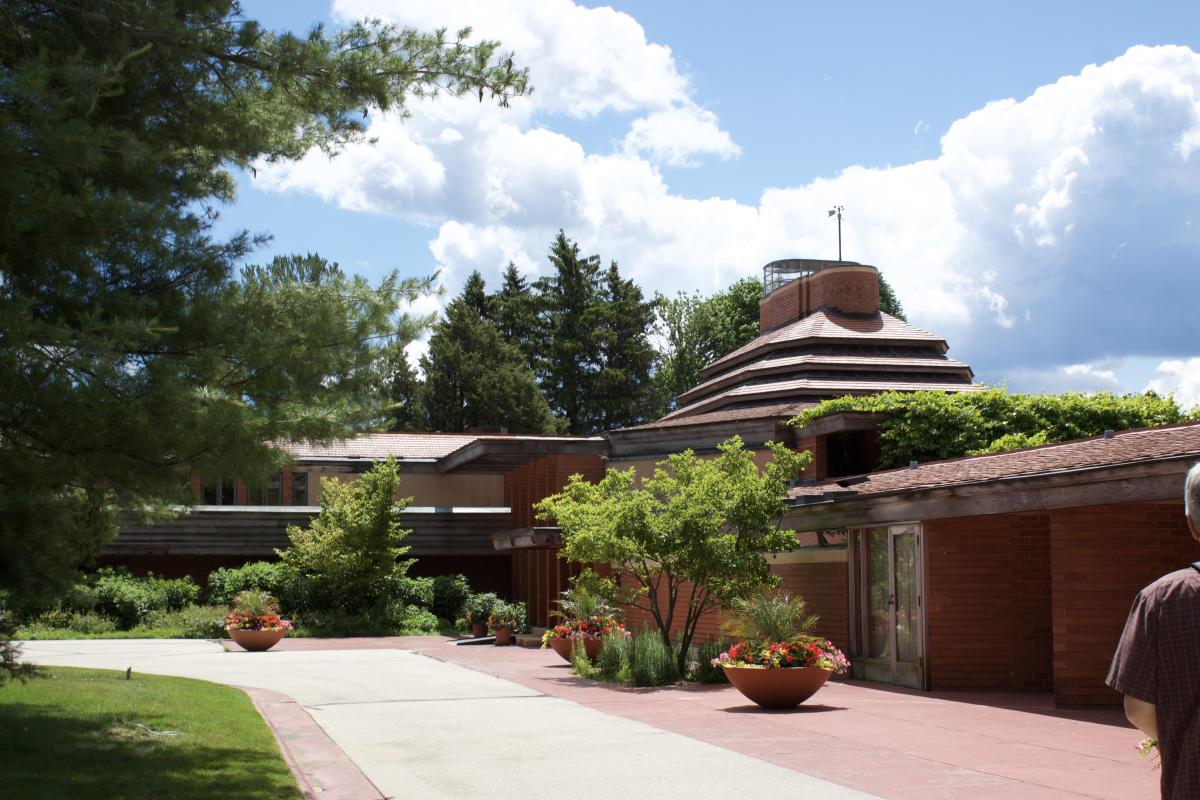
Johnson Foundation Wingspread Conference Center
33 E. 4 Mile Rd., Wind Point
Herbert F. Johnson, Jr., commissioned Frank Lloyd Wright to build Wingspread, his 14,000 sq. ft. Prairie style home, which was completed in 1939. One of the largest Wright-designed private homes, it featured many characteristics of Wright's organic architecture such as horizontal lines and low ceilings. Wingspread has four wings, each created for specific purposes. The home was occupied for 20 years by Mr. Johnson and his wife, Irene Purcell, and their two children, Karen and Sam. In 1959, they donated the home so it could be converted into the conference center, which it is now known as The Johnson Foundation at Wingspread.
When entering Wingspread, you will begin to understand Mr. Wright's emphasis on manipulation. The compressed entry ceiling pushes you into the grandeur of the Great Hall with its central wigwam. Narrow hallways are an additional way to encourage you to move through quickly and realize the gathering spaces. The multiple fireplaces draw you to the large gathering spaces, which were to be used for family and social time. The wings of Wingspread were designed to separate the public and private spaces. Numerous windows allow the outdoors to be brought indoors, a goal of Mr. Wright's architecture. The free Wingspread tour highlights remarkable features such as the home's disappearing dining table, its teepee-inspired clerestory ceiling in the great room, and the cantilevered "Romeo and Juliet" balcony bedroom. To schedule a tour, visit their website.
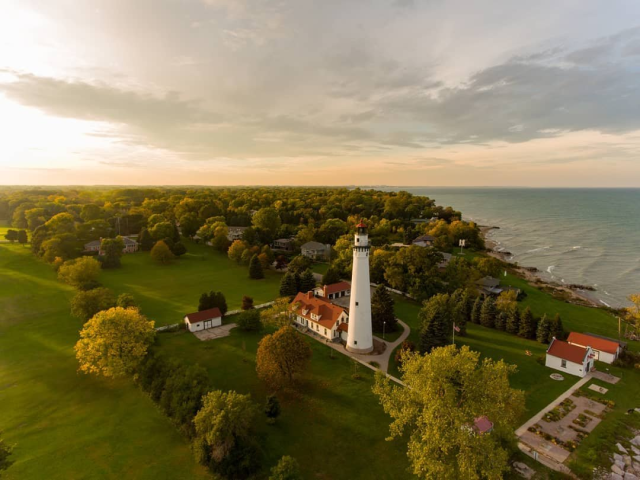
Wind Point Lighthouse
4725 Lighthouse Dr., Wind Point
The Wind Point Lighthouse is the oldest and tallest working lighthouse on Lake Michigan. The 108-foot structure was built in 1880 to warn ships away from the shallow waters off Wind Point. The beacon, magnified by a Fresnel lens imported from France, was originally a mineral oil lamp. A lighthouse keeper and two assistants were needed to maintain and operate the light 24 hours a day. The light can be seen 19 miles away. The light was later converted to electricity and the lighthouse became fully automated in 1964. Today, the building serves as Village Hall and home of the Wind Point Police Department. The hall and south lawn of the grounds are available to rent for weddings and special events. A rigorous climb up the 144 steps delivers spectacular views of Lake Michigan and the surrounding countryside. The lighthouse tower is open for public tours on certain dates during the year. Reservations are recommended, but not required. The lighthouse was listed on the National Register of Historic Places in 1980.
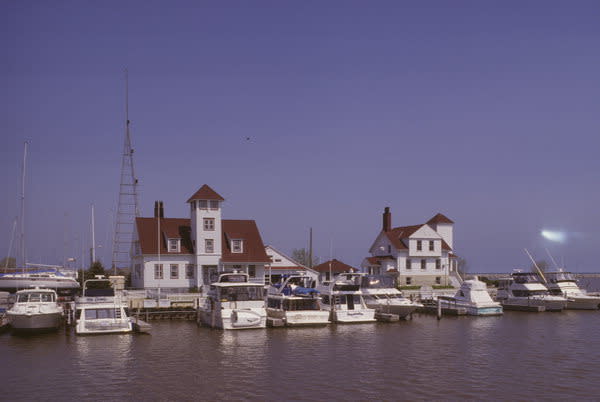
Racine Harbor Lighthouse and Life Saving Station
Reichert Ct., North Pier at Entrance to Racine Harbor
Built in 1866, the lighthouse was designed in the Queen Anne architectural style. It stood on a rock filled crib two hundred feet off shore. In 1903, the light was moved to a steel tower further out on the north pier. Also that year, a two-story life saving station with a pyramidal-roofed lookout tower was completed. In 1915, the Life Saving Service merged with the U.S. Coast Guard and the island status of the lighthouse ended. The pier was filled in and piling pulled from under the structures. The buildings now stand on a man-made peninsula built out from the mainland over a period of years. In 1973, the U.S. Coast Guard discontinued its service in Racine. Today, the lighthouse and life saving station serve as quarters for the Racine County Water Safety Patrol.
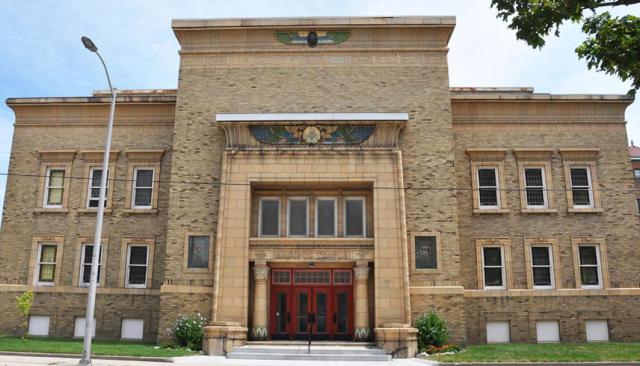
Racine Masonic Center
1012 Main St., Racine
The Racine Masonic Center features two historic structures blended together. A three-story Italianate mansion built in 1856 was joined by the Masonic Temple in 1922. The mansion was built by early Racine businessman Henry Durand and his family who lived there until 1890 when Otis Johnson purchased the home. It was later acquired by Frederick Robinson who undertook an extensive renovation in 1906 and provided for the home to be sold to the local Freemasons. The mansion was deeded to the masons in 1922 and in 1923, the grand lodge rooms and dining facilities were added to the back of the mansion on the Wisconsin Avenue side. The temple portion was designed by local architect Edmund Funston. The Racine Masonic Center closed in November 2021. Click here to learn more about the history of the Henry S. Durand Mansion.

Racine County Visitor Center
14015 Washington Ave., Sturtevant
The Racine County Visitor Center is the home of the Racine County Convention and Visitors Bureau, the county's official tourism promotion and development organization. Built in 2000, the building was designed by Ken Dahlen/Genesis Architecture of Racine, Wisconsin. They were given the task of designing a building with a "Frank Lloyd Wright/lighthouse" feel. The 4,000 sq. ft. facility contains a 2,000 sq. ft. visitors center, restrooms, meeting room, kitchenette, offices, and a partial basement. Local, regional and state brochures are available for free at the visitors center.
Want to delve deeper into Racine County architecture? Below are houses and more buildings with stories of historical significance. (All photos are from the Wisconsin Historical Society.)

Emily Baker House, 116 10th St., Racine
Emily Baker allegedly built this house in 1894 as an addition to an existing house, which had the address of 939 Main St. After the addition, the house faced East Park and 10th St., so 939 Main St. disappeared as an address. It was designed in the Dutch Colonial Revival architectural style, but has the irregular plan of the Queen Anne style. It served as both a private residence and a nursing school dormitory. Today, it operates as the Christmas House Bed & Breakfast.
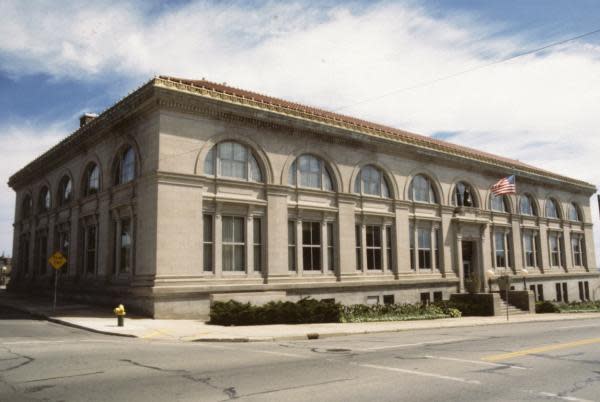
J. I. Case Headquarters, 700 State St., Racine
Founded in 1844, the J. I. Case Company helped transform Racine into an important manufacturing city. Jerome Case developed a threshing machine that efficiently separated the grain from the stalk and cleaned the chaff from the grain in one operation. Soon his company became Racine's largest employer and the world's leading threshing machine manufacturer.
In 1904, when Case introduced the first all-steel thresher, the company built a new headquarters in the Beaux-Arts Classical style. Inspired by the much-admired Boston Public Library, architects Wilson and Guilbert utilized two-story arched windows separated by classical pilasters along the length of the façade. Classical moldings trim the cornice, and a low-hipped tile roof crowns the building. The entire composition rests atop an elevated basement. Above the central entrance is Case Company's logo of an eagle perched on a globe. The grand interior space, two stories high, was divided into separate floors in 1957.

Chauncey Hall Building, 338-340 Main St., Racine
Built in 1883, the Chauncey Hall building was designed by Edward Townsend Mix in the German Renaissance Revival architecture style. From the late 1920s until the mid-1950s, the building was home of the Pokorny Drug Store. Other occupants included a men's clothing store (circa 1887), upholsterer, food co-op, dress shop, and an architect's office. In 1994, a bistro restaurant occupied the first floor.
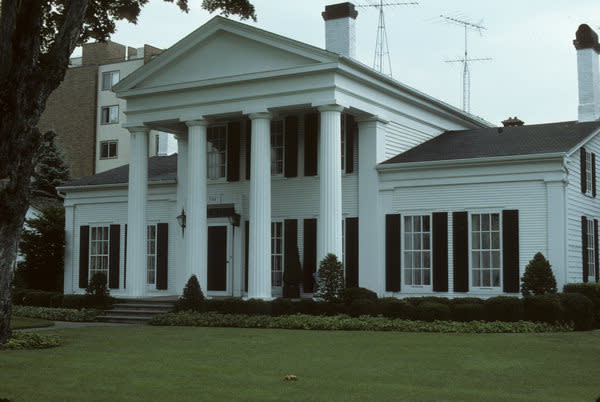
Eli R. Cooley House, 1135 S. Main St., Racine
This house was built circa 1851 by Lucas Bradley for Eli R. Cooley, a hardware dealer and Racine's third mayor. It was designed in the Greek Revival architectural style. In 1942, William and Amanda Kuehneman bought the house and carefully restored it. The house is considered perhaps the best remaining example of a Greek Revival house in Wisconsin.
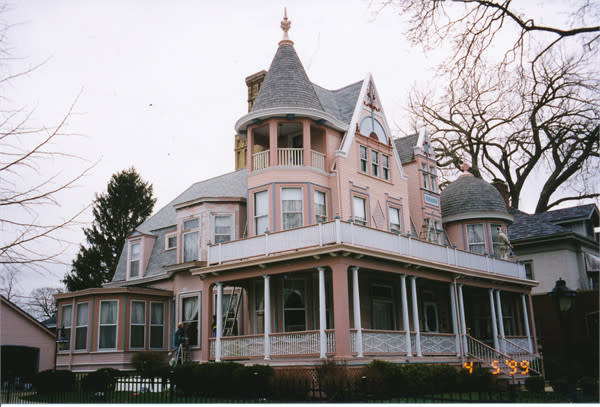
Julia M. and August Charles Frank House, 1520 College Ave., Racine
Built in 1894, architect A. L. Flegel designed this house in the Queen Anne architectural style. It has a two-story domed tower on one corner and a three-story tower with open third floor on the opposite corner, bays and dormers, carved panels, and a doric spindlework porch. The house was built for Julia and August Frank next door to her parents, Ernest and Martha Hueffner (see Thomas Jones House). Mr. Frank was a financier, lecturer and explorer from Egypt who brought the mummy that is at the Racine Heritage Museum. he house was supposedly modeled after a French chateaux the Franks saw during their travels. They lived in the house until August's death in 1927.
The house remained vacant until 1941 when it was purchased by restaurateur Arthur Meyer who operated the Park Place Tea Room and catering service out of the house. During the 1950s, Don Hutson, former Green Bay Packer, lived in the house. From 1965 to 1968, George and Dorothy Neilson lived in the house their eight children. In 1973, Jim and Pat Dickert bought the house and began restoration. In 1988, Doug and Gail Julius purchased it and opened it as the College Avenue Bed & Breakfast. They added the garage and driveway, finished the attic, and renovated other parts of the house. In 1997, Tom and Vanessa Reynolds purchased the house and extensively restored the exterior.

Thomas P. Hardy House, 1319 S. Main St., Racine
In 1905, Frank Lloyd Wright designed this house in the Prairie School architectural style. The house was built on a bluff along Lake Michigan for Thomas P. Hardy, a Racine attorney. The front of the three-story stucco house faces Lake Michigan. The house is almost flush with the sidewalk and the hill has a steep drop towards the lake. Two entrances punctuate the wall and lead to a narrow central corridor that serves as a secondary buffer between the street and the primary living spaces at the rear of the house. The limited fenestration at the front of the house contributes to the overall impression of privacy with a thin band of square-shaped windows running below the second story soffits and very small rectangular windows set back into the wall on the first story. Large windows in the living room and an upper story balcony create expansive views of the lake. For more information, visit Frank Lloyd Wright Sites.
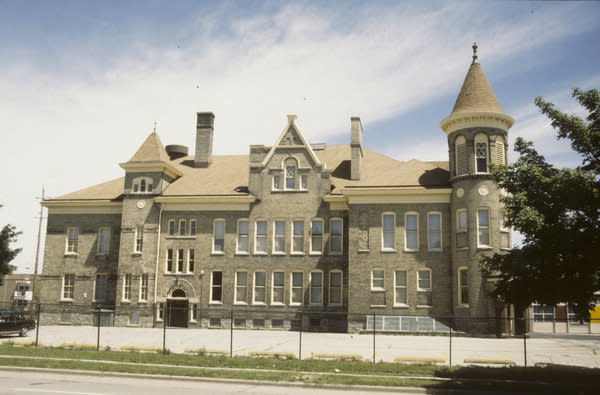
Janes Elementary School, 1425 N. Wisconsin St., Racine
Among Racine's oldest schoolhouses, the Fourth Ward School was the first schoolhouse built on this site in 1855 by architect Lucas Bradley. He designed the two-story cream brick High Victorian Italianate building with a cupola similar to two other ward schools of the same plans (Third Ward School known as Winslow Elementary School and Fifth Ward School known as Garfield School). In 1883, James Gilbert Chandler designed the additions that removed what was left of the original school. A close examination of the building reveals fine brickwork and detail. The tall, cylindrical tower, high-pitched gables, and ornamental sheet metal trim are features of the picturesque French Chateauesque style that Mr. Chandler favored. When the additions were made, the school was renamed Janes School in honor of Lorenzo Janes, one of Racine's first lawyers who owned much property on the northside and donated the land for the school. He served the territorial council of Wisconsin and was publisher of Racine's first newspaper called Racine County Argus.
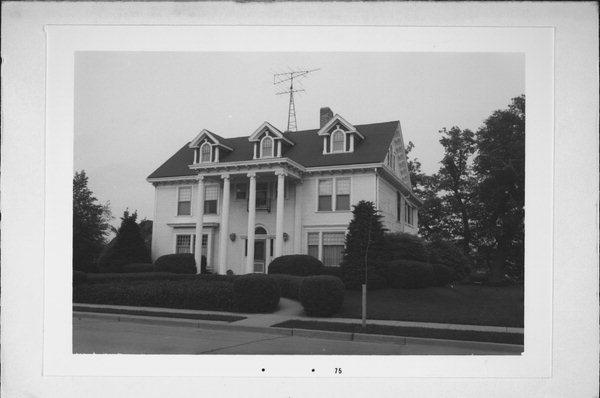
Helen and Herbert Fisk Johnson House, 1725 Wisconsin Ave., Racine
In November 1895, Herbert Fisk Johnson and his father, Samuel Curtis Johnson, each bought a parcel of land next to each other on the east side of Wisconsin Ave. (see Caroline and Samuel Curtis Johnson House). In 1898, this house was built in the Georgian Revival architectural style. The house has returned eaves and round arch windows with keystone in the dormers and a Palladian motif door with sidelights and gable window. The two-story portico was added in the 1960s.
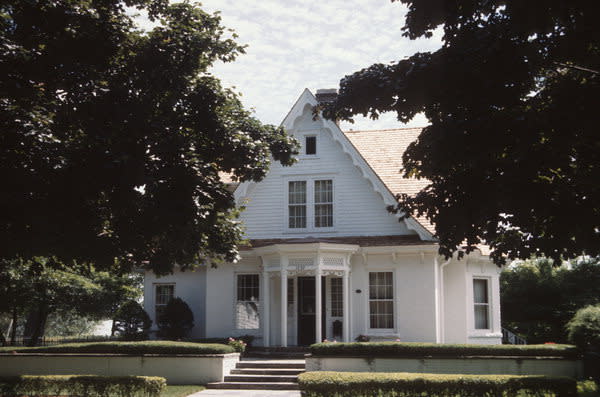
Caroline and Samuel Curtis Johnson House, 1737 Wisconsin Ave., Racine
In November 1895, Samuel Curtis Johnson and his son, Herbert Fisk Johnson, each bought a parcel of land next to each other on the east side of Wisconsin Ave. (see Helen and Herbert Fisk Johnson House). In 1903, Mr. Johnson, founder of S. C. Johnson & Son, designed this house in the Gothic Revival architectural style. The house is a small, brick cottage with steeply sloping, intersecting-gable roofs, bargeboards, and lacy woodwork on the front porch. The interior features parquet floors laid by Mr. Johnson. An attractive formal garden to the south of the house was created in 1935 and was restored in 1968.

Thomas Jones House, 1526 College Ave., Racine
Built in 1878, this house was built by Thomas and Jane Jones in the High Victorian Italianate architectural style, but is asymmetrical in form. Mr. Jones was a lumber dealer with Jones, Knapp & Co. The exterior of the house is Milwaukee brick with a stone foundation and wood trim. It has paired brackets under the eaves, carved stone lintels, a two-story bay on the front, barge boards in the gable, and elaborate heavy porch supports. In 1887, Ernest and Martha Hueffner purchased the house. Mr. Hueffner was a dealer in leather with a wholesale leather store. He also one of the founders and later president of the Manufacturers' National Bank. He served as a Racine alderman for a number of terms and as Racine mayor from 1879 to 1880. The Hueffners had nine children. Their daughter, Julia, married August Frank and built a house next door (see Julia M. and August Charles Frank House.). Mrs. Hueffner died in 1916 and Mr. Hueffner died in 1922. The house remained in the family until it was sold to Donald Evans in 1939. In 1943, Jerome and Margaret Weichers purchased the house and did a lot of renovation, including electrical and plumbing. In 1962, Kenneth and Ellen Schaffer purchased the house. In 1998, Roy and Sharon Ramquist purchased the house and renovated it room by room, brining it back to its original beauty.
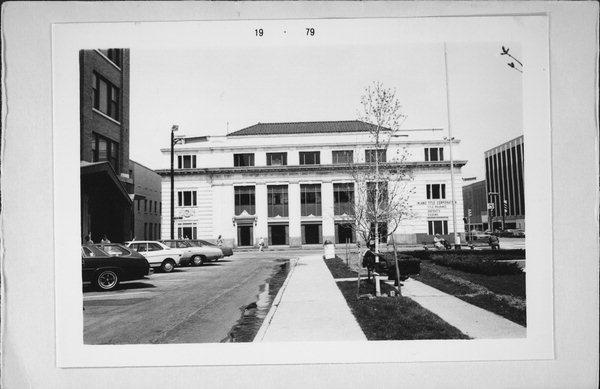
Manufacturers' National Bank, 441 S. Main St., Racine
Refaced in 1919, the Manufacturers' National Bank was designed in the Neoclassical architectural style. In 1871, the first bank to be founded in Racine (1845) merged with another to form the Manufacturers' National Bank. A year later, they leased this building and, in 1876, became its owner. Originally a three-story brick, Italianate structure, the building was completely refaced in 1919.
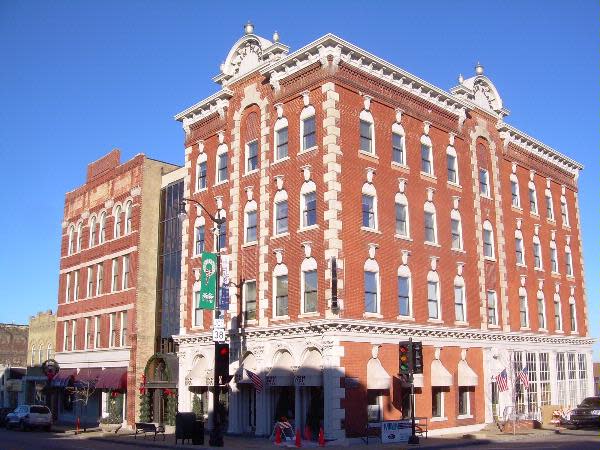
McClurg Building, 245 Main St., Racine
Built in 1857, the McClurg Building was built by Alexander McClurg in the High Victorian Italianate architecture style. Built to house offices of Racine's first railroad, the Racine and Mississippi Railroad. It also housed the first public library, the first Turkish bath, the first municipal court, and first vaudeville and movie theaters including the Bijou Theatre.

Daniel Olin House, 1144 Main St., Racine
Built in 1868, architect Lucas Bradley designed this house in the Italianate architectural style. The house was made of cream brick with brackets under the eaves, moulded window hoods, a bay on the side, and paired brackets and round arched windows in the cupola. In 1878, Daniel and Mariette Olin lived in this house. Mr. Olin was a mayor and worked in the railroad business. He ran the first passenger train from Milwaukee to the Mississippi River in 1852. He came to Racine as the general superintendent of the Western Union Railroad, which became a part of the Chicago, Milwaukee, and St. Paul. Mr. Olin died in 1893 and Mrs. Olin lived in the house until her death in 1909.
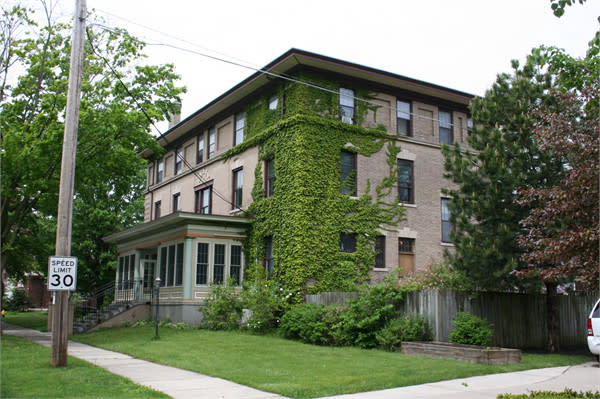
John and Eliza Palmeter House, 1547 College Ave., Racine
Built in 1904, this house was designed by Guilbert and Rugh in the Neoclassical architectural style. The house was made of cream brick with brickwork quoins, stone lintels with keystones, a half-round sunporch and rectangular entry porch, and dentilled eaves. The house was owned by John and Eliza Palmeter, a childless couple who devised their estates to the providing of a home for elderly women of limited means. Mr. Palmeter worked as a carriage maker and later established a successful real estate agency. He died in 1889 and left his estate to Mrs. Palmeter who incorporated the John H. Palmeter's Old Ladies Home before she died in 1895. The building opened in 1905, and for nearly 90 years, this residence provided a home for the fortunate old ladies who lived here. It eventually became too costly to operate and closed in 1993.
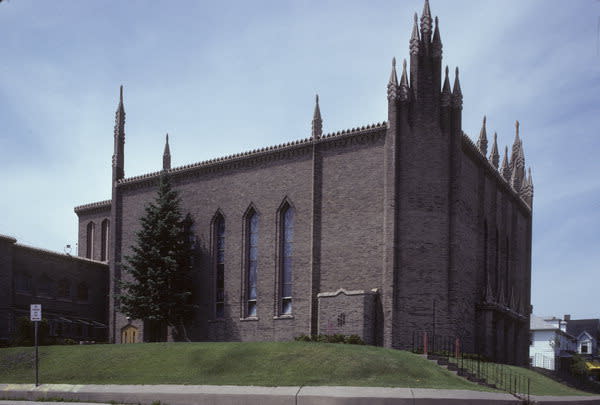
St. Patrick's Roman Catholic Church, 1100 Erie St., Racine
Built in 1924, Francis Barry Byrne designed this building in the Neogothic Revival architectural style with a unique mix of prairie school and art deco influences. Its unusual design is believed to have been inspired by Mr. Byrne's work with Frank Lloyd Wright on the Unity Temple. The building features sculptures by Alfonso Ianelli who also worked with Mr. Wright.

Winslow Elementary School, 1325 Park Ave., Racine
Among Racine's oldest schoolhouses, the Third Ward School was the first schoolhouse built on this site in 1855 by architect Lucas Bradley. He designed the two-story cream brick High Victorian Italianate building with a cupola similar to two other ward schools of the same plans (Fourth Ward School known as Janes Elementary School and Fifth Ward School known as Garfield School). In 1897, James Gilbert Chandler designed the additions that remodeled this building. He added dormers and the tall entrance pavilions with ornamental sheet work. The school was renamed after Horatio G. Winslow, a well-known local educator.

